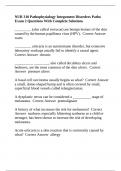NUR 310 Pathophysiology Integument Disorders Patho
Exam 2 Questions With Complete Solutions
_________ (also called verrucae) are benign lesions of the skin
caused by the human papilloma virus (HPV). Correct Answer
warts
_________ urticaria is an autoimmune disorder, but extensive
laboratory workups usually fail to identify a causal agent.
Correct Answer chronic
__________ ________, also called decubitus ulcers and
bedsores, are the most common of the skin ulcers. Correct
Answer pressure ulcers
A basal cell carcinoma usually begins as what? Correct Answer
a small, dome-shaped bump and is often covered by small,
superficial blood vessels called telangiectasias.
A dysplastic nevus can be considered a __________ stage of
melanoma. Correct Answer premalignant
A history of what increases the risk for melanoma? Correct
Answer sunburn, especially blistering sunburns as a child or
teenager, has been shown to increase the risk of developing
melanoma.
Acute urticaria is a skin reaction that is commonly caused by
what? Correct Answer allergy
,Acute urticaria occurs as a discrete, sudden episode, often
following the ingestion exposure to what? Correct Answer of
medicine, food, or drinks, or following insect stings, viral
infections, and exposure to dust mites, pollens, and chemicals.
Adolescents and adults with _______- have dry, lichenified
lesions that are either hypo- or hyperpigmented; these lesions
are usually seen in the antecubital and popliteal areas, spreading
to the neck, hands, feet, eyelids, and behind the ears. Correct
Answer eczema
Allergy-prone children, especially those with ______ and
_______-, are particularly susceptible to acute urticaria. Correct
Answer eczema and rhinitis
Although the lesions of psoriasis can appear anywhere on the
body, they are frequently seen where? Correct Answer on the
extensor surfaces of elbows and knees, and on the scalp.
An acute paronychia is most often caused by ____________
_____________ and an abscess is commonly present. Correct
Answer Staphylococcus aureus
An obvious black region under the nail can indicate what?
Correct Answer melanoma beneath the nail or subungual
hemorrhage caused by trauma.
Any change in size, color, border, or appearance of a nevus can
indicate what? Correct Answer malignant melanoma.
,Approximately 30% of melanomas occur where? Correct
Answer a nevus
Are bed bug bites painful? Correct Answer no just itchy
As Part of the Examination of the Skin, It Is Important to
Conduct a Complete History That Elicits Information About
what 9 things? Correct Answer -Initial appearance of the lesion
-Symptoms associated with its eruption
-History of allergies
-Medication use
-Exposure to insects, irritants, or ultraviolet light
-Other associated systemic symptoms
-Current or previous illnesses
-Presence of photosensitivity
-Remedies the patient has used to treat his or her skin lesions
As this lesion enlarges and begins to fade, usually between days
__ and ___, successive patches appear on the neck and trunk.
Correct Answer 2 and 10
Atypical or dysplastic nevi are those that look like what?
Correct Answer irregular in shape, variegated in color, and have
a high susceptibility to cancerous change.
Basal cell carcinomas grow how? Correct Answer grow slowly
and deeply, taking months or years to become sizable.
Beau's lines are transverse linear depressions across the nail that
can also be caused by what? Correct Answer trauma or
Raynaud's Syndrome
, Because these lesions are itchy, what can occur? Correct
Answer inflammation and infection
Bed bugs, known as Cimex lectularius, are insects associated
with what? Correct Answer a lack of clean mattresses or
bedding.
Change in what 3 things can indicate melanoma? Correct
Answer A change to the shape, color, or diameter of a mole can
be a warning sign of melanoma.
Chronic illness can cause pitting of the nails or depressions
called what? Correct Answer Beau's Lines
Chronic paronychias are commonly caused by what? Correct
Answer Candida (yeast) infection.
Commonly called what 3 things? Correct Answer solar
lentigos, liver spots, or age spots
Contact dermatitis affects what parts of the body? Correct
Answer the head, neck, trunk, arms, hands, abdomen, groin, and
lower extremities.
Contact dermatitis, another type of skin inflammation,
represents what? Correct Answer delayed hypersensitivity to
materials such as metals, chemicals, drugs, and poison ivy.




